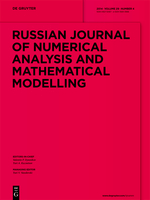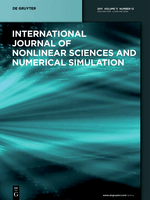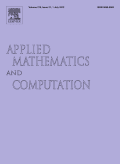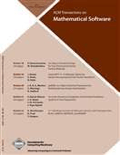
RUSSIAN JOURNAL OF NUMERICAL ANALYSIS AND MATHEMATICAL MODELLING
Scope & Guideline
Advancing the Frontiers of Numerical Analysis and Mathematical Insight
Introduction
Aims and Scopes
- Numerical Analysis and Computational Methods:
The journal publishes research on numerical methods for solving differential equations, optimization problems, and other mathematical challenges, showcasing innovative algorithms and computational techniques. - Mathematical Modelling:
It emphasizes mathematical modeling across various fields, including physics, biology, engineering, and environmental science, providing insights into complex systems through mathematical representations. - Interdisciplinary Applications:
The journal encourages submissions that apply numerical and modeling techniques to interdisciplinary problems, demonstrating the versatility of these methods in addressing real-world challenges. - Stochastic and Deterministic Approaches:
Research covering both stochastic and deterministic frameworks is highlighted, reflecting the journal's commitment to diverse methodologies in numerical analysis and modeling. - Innovative Simulation Techniques:
The journal features advancements in simulation techniques, such as Monte Carlo methods, finite element methods, and other innovative approaches that contribute to numerical analysis.
Trending and Emerging
- Climate and Environmental Modeling:
The journal has seen a substantial increase in papers focusing on climate modeling and environmental systems, reflecting the growing importance of these areas in the context of global climate change. - Stochastic Processes and Uncertainty Quantification:
There is a rising interest in stochastic modeling and uncertainty quantification, highlighting the need for robust methods to address variability and uncertainty in complex systems. - Machine Learning and Data Assimilation:
The integration of machine learning techniques with numerical modeling and data assimilation processes is gaining traction, showcasing the journal's commitment to modern computational approaches. - Multiscale and Multiphysics Modeling:
An increasing number of studies are exploring multiscale and multiphysics modeling, indicating a trend towards addressing complex interactions in systems that span multiple scales and physical phenomena. - Advanced Numerical Methods and Algorithms:
The journal is increasingly publishing innovative numerical methods and algorithms, particularly those that enhance computational efficiency and accuracy in simulations.
Declining or Waning
- Traditional Fluid Dynamics Models:
There has been a noticeable decrease in papers focusing solely on classical fluid dynamics models, indicating a potential shift towards more complex, multi-physics simulations that incorporate additional factors. - Basic Statistical Modelling:
Research centered on fundamental statistical modeling techniques appears to be waning, as the journal increasingly highlights advanced computational methods and interdisciplinary applications. - Static Mathematical Models:
The prevalence of static models in mathematical research is declining, with a growing trend towards dynamic and time-dependent models that better capture real-world phenomena. - Single-Disciplinary Studies:
There is a diminishing focus on studies that are confined to a single discipline, as the journal increasingly prioritizes interdisciplinary research that addresses complex problems through collaborative approaches.
Similar Journals

APPLIED MATHEMATICAL MODELLING
Unleashing the Power of Mathematics for Real-World ApplicationsApplied Mathematical Modelling is a premier journal published by Elsevier Science Inc, dedicated to advancing the field of applied mathematics through the dissemination of high-quality research. With an impressive Impact Factor that places it in the Q1 category for both Applied Mathematics and Modeling and Simulation, this journal has established itself as a critical resource for researchers and practitioners alike, boasting a Scopus rank of #17 out of 635 in Applied Mathematics and #15 out of 324 in Modeling and Simulation. Since its inception in 1976, it has provided a vital platform for innovative models and techniques that drive progress across various scientific disciplines. Researchers will find an extensive range of articles addressing contemporary issues and developments, making it an essential read for anyone interested in the application of mathematical frameworks to real-world problems. While the journal maintains a subscription-only access model, its impactful contributions ensure that it remains an influential voice in the landscape of applied mathematics.

COMPUTATIONAL MATHEMATICS AND MATHEMATICAL PHYSICS
Exploring Complex Problems with Precision and InsightCOMPUTATIONAL MATHEMATICS AND MATHEMATICAL PHYSICS is a prestigious journal published by PLEIADES PUBLISHING INC, dedicated to advancing the fields of computational mathematics and mathematical physics. With an ISSN of 0965-5425 and an E-ISSN of 1555-6662, the journal has established its importance within the academic community since its inception in 1985. It is classified in the third quartile (Q3) for computational mathematics in 2023, and while currently it does not offer open access options, it remains a valuable resource for researchers seeking to disseminate their findings and engage with cutting-edge developments in the field. The journal encompasses a broad spectrum of topics, including numerical analysis, applied mathematics, and the intersection of physics and computational techniques, highlighting its relevance in addressing complex problems in both theoretical and applied contexts. Scholars will find a platform that not only promotes rigorous research but also encourages collaboration and innovation within the scientific community.

Eurasian Journal of Mathematical and Computer Applications
Innovating Solutions through Mathematical and Computational Research.Eurasian Journal of Mathematical and Computer Applications, published by the prestigious L N GUMILYOV EURASIAN NATIONAL UNIVERSITY in Kazakhstan, stands as a vital platform for researchers and professionals engaging in the fields of Applied Mathematics, Computational Mathematics, Computer Science Applications, Information Systems, Mathematical Physics, and Modeling and Simulation. With its ISSN 2306-6172 and E-ISSN 2308-9822, this academic journal aims to foster innovative research and facilitate knowledge transfer in these interdisciplinary domains. The journal, which converges its endeavors from 2013 to 2024, is currently ranked Q3 across its various categories in 2023, reflecting its growing influence and commitment to academic excellence. Despite its open access availability, the journal's dedication to quality research is evident as it attracts contributions that not only advance theoretical understanding but also address practical applications. With a supportive community of researchers in an increasingly important field, the Eurasian Journal of Mathematical and Computer Applications is poised to remain a significant resource for those seeking to propel the boundaries of mathematical and computational sciences.

INTERNATIONAL JOURNAL OF NONLINEAR SCIENCES AND NUMERICAL SIMULATION
Exploring the Dynamics of Complexity and ComputationINTERNATIONAL JOURNAL OF NONLINEAR SCIENCES AND NUMERICAL SIMULATION, published by WALTER DE GRUYTER GMBH, serves as a premier platform for advancing knowledge in the vibrant domains of applied mathematics, computational mechanics, and various fields of engineering and physics. With an ISSN of 1565-1339, this journal has been at the forefront of disseminating significant research findings since its inception in 2000. Its commitment to quality is reflected in its category quartiles for 2023, ranked Q2 in Computational Mechanics and Engineering (miscellaneous), and Q3 in multiple engineering disciplines. Although it currently operates under a subscription model, the journal remains dedicated to presenting groundbreaking studies that explore complex nonlinear phenomena and numerical methodologies. As an invaluable resource for researchers, professionals, and students alike, the journal aims to foster innovation and collaboration across related fields, enhancing both theory and application through its peer-reviewed articles.

Frontiers of Mathematics
Charting New Paths in the Realm of MathematicsFrontiers of Mathematics, published by SPRINGER HEIDELBERG, is an emerging academic journal dedicated to fostering the advancement of mathematical sciences from 2023 to 2024. With an ISSN of 2731-8648 and E-ISSN of 2731-8656, this journal is positioned in the category of Q2 in the miscellaneous mathematics domain, showcasing its commitment to quality research and innovation. Although in its nascent stages, it has swiftly established a foothold within the global academic landscape, holding a Scopus rank of #198/399 and a median percentile of 50, indicating a promising trajectory. By providing an open-access option, Frontiers of Mathematics ensures broad dissemination of research findings, fostering collaboration and knowledge sharing across the mathematical community. Researchers, professionals, and students alike will find this journal to be an invaluable resource, contributing to important discussions and advancements in various mathematical fields.

JAPAN JOURNAL OF INDUSTRIAL AND APPLIED MATHEMATICS
Transforming Ideas into Mathematical SolutionsThe Japan Journal of Industrial and Applied Mathematics, published by Springer Japan KK, is a pivotal platform for disseminating cutting-edge research in the fields of applied mathematics and engineering. With an ISSN of 0916-7005 and an E-ISSN of 1868-937X, this journal has been a cornerstone in the academic community since its inception in 1991 and will continue to contribute pivotal insights through 2024. Positioned in the Q3 category for both Applied Mathematics and Miscellaneous Engineering according to 2023 rankings, it is recognized for its diverse range of topics and interdisciplinary approaches. Despite its competitive ranking, the journal fosters valuable contributions that challenge conventional methodologies and inspire innovation. Researchers, professionals, and students alike will find the journal’s contents invaluable for advancing knowledge and exploring new methodologies in industrial and applied mathematics.

APPLIED MATHEMATICS AND COMPUTATION
Elevating Research Standards in Applied MathematicsApplied Mathematics and Computation is a premier journal dedicated to the dissemination of high-quality research in the field of applied mathematics and computational methods. Published by Elsevier Science Inc, this influential journal has established itself as a key resource for researchers, professionals, and students interested in mathematical modeling, numerical analysis, computational algorithms, and their applications across various disciplines. With an impressive impact factor reflecting its scholarly credibility, it holds a distinguished position in the Q1 quartile for both applied and computational mathematics as of 2023, ranking #31/635 and #12/189 in Scopus categories respectively, thereby indicating its significant impact on the academic community. The journal encompasses a broad spectrum of topics, encouraging original research, critical reviews, and innovative methodologies that address real-world challenges. Although it currently does not offer open access options, it remains a cornerstone publication for those at the forefront of mathematical research, continuously bridging theory with practical computation since its inception in 1975.

ESAIM-Mathematical Modelling and Numerical Analysis
Advancing Mathematical Frontiers with PrecisionESAIM-Mathematical Modelling and Numerical Analysis, published by EDP SCIENCES S A, is a prestigious open-access journal at the forefront of the fields of mathematical analysis, applied mathematics, computational mathematics, modeling, simulation, and numerical analysis. With an impressive Q1 ranking in multiple categories for 2023, the journal is recognized for its contribution to advanced research, particularly in areas that intertwine mathematical theory with practical applications. The journal’s ISSN is 2822-7840 and its E-ISSN is 2804-7214, showcasing its commitment to both traditional and digital dissemination of knowledge. Spanning from 1996 to 2024, ESAIM has established itself as a vital platform for scholars seeking to publish innovative research and engage with the latest advancements in the field. Researchers and practitioners can explore the journal’s content through various access options, fostering a collaborative environment for the sharing and development of new mathematical methodologies. Situated in France, ESAIM continues to attract an international readership, driving forward the global discourse in mathematical sciences.

ACM TRANSACTIONS ON MATHEMATICAL SOFTWARE
Driving progress in applied mathematics and software solutions.Welcome to the ACM Transactions on Mathematical Software, a prestigious journal published by the Association for Computing Machinery (ACM). With an ISSN of 0098-3500 and an E-ISSN of 1557-7295, this journal has been at the forefront of innovation in the field since its inception in 1975. It serves as a critical platform for researchers, professionals, and students, facilitating the dissemination of advanced mathematical techniques and software developments. The journal is recognized for its outstanding impact, evidenced by its Q1 classification in Applied Mathematics and Q2 in Software for 2023, along with an impressive Scopus ranking placing it in the 85th percentile for Applied Mathematics and the 58th percentile for Computer Science. Our objective is to publish high-quality research that explores new methodologies in mathematical software and their applications, driving the field forward. Although not an open access journal, the relevance and rigor of the content ensure that it remains a valuable resource in mathematical and computational sciences. Join us in exploring the latest in mathematical software and contribute to shaping future advancements.

CSIAM Transactions on Applied Mathematics
Bridging Theory and Practice in MathematicsCSIAM Transactions on Applied Mathematics is a prestigious academic journal published by GLOBAL SCIENCE PRESS, specializing in the rapidly evolving field of applied mathematics. Established in 2020 and operating in Hong Kong, this journal has quickly gained recognition for its rigorous peer-reviewed articles and contributions that integrate theoretical frameworks with practical applications. With an impressive ranking of #261 out of 635 in the Scopus database, and a 2023 quartile ranking of Q2 in Applied Mathematics, it is positioned to be a vital resource for researchers, professionals, and students alike. The journal offers a platform for innovative research that is essential for addressing contemporary challenges in science and engineering, promoting interdisciplinary collaboration and knowledge exchange. Although currently not Open Access, it provides invaluable insights through its curated content, truly reinforcing its role as a cornerstone in the field of applied mathematics.